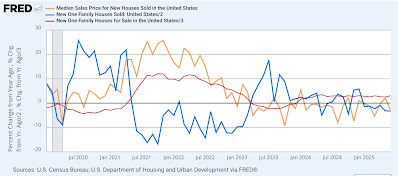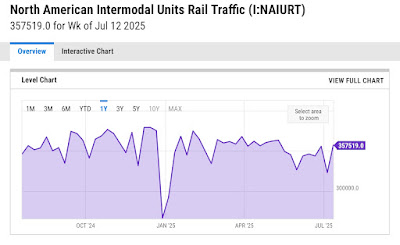- by New Deal democrat
There was no big economic news today, despite the report on durable goods, which declined -9.3% in June — after a 16.5% advance in May. Simply put, it was all about aircraft orders from Boeing. Take out transportation, and orders rose 0.6% in May and 0.2% in June. The more important core capital goods number declined -0.7% after a 2.0% increase in May. Even more fundamentally, in addition to being very noisy (see above), sometimes durable goods orders lead, and sometimes they don’t. So I don’t normally pay much attention to them.
But what I do pay a lot of attention to is consumer spending, and today I want to address variations on a graph I have seen in various places in the past few weeks. Below is a graph of real retail sales, total real personal consumption, and real personal consumption on goods, all normed to 100 as of last December:
It doesn’t take a genius to see that these are all trending sideways or down since then. So the claim is that real consumer spending has been flat this year.
True in the most literal sense, compared with last December. But now let’s look at the monthly changes since December 2023:
Note that the two biggest declines were in each January, and that each December was above average. Holiday spending is always difficult to seasonally adjuste, and has been especially so in the wake of COVID. In other words, this suggests very strongly that there is some unresolved Holiday seasonality in the December vs. January numbers.
Probably the best way to deal with this issue is to average December and January together. FRED doesn’t let us do that (and regrettably is not set up for 3 month moving averages either), but another way to minimize the impact of this residual seasonality is to use quarterly rather than monthly data. And that’s what the below graph does, with the monthly data in narrow lines, with the quarterly averages of the same data in bold thicker lines (note that the Q2 average isn’t available yet for the two personal spending series) :
Now we can see that while spending has decelerated, the trend still appears to be higher. In other words, the choice of December as the starting point is carrying a lot of weight in the suggestion that consumer spending has stalled in 2025.
Finally, even if I can’t show you in FRED, below are the three month averages starting with October-December 2024, and averaging December and January together:
Months: Retail sales, Total PCE, Goods PCE (US$ Billions)
Oct-Dec 2024: 224.6. 16.26. 5.54
Nov 24- Jan 25: 224.7. 16.30. 5.56
Dec 24 - Feb 25: 223.9. 16.29. 5.56
Jan-Mar 2025: 224.4. 16.31. 5.58
Feb-Apr 2025: 224.7. 16.33. 5.59
Mar-May 2025: 224.9. 16.36. 5.61
Apr-Jun 2025*: 224.2. N/A
*(only retail sales available)
While real retail sales have indeed trended sideways since last autumn, note that the highest 3 month average was in May of this year, followed by April (tied with January). But the 3 month averages of both total and goods real personal spending have almost uniformly trended higher throughout this period.
Personal income and spending will be reported next Thursday. At that point we will have a much better look at the Q2 trend in real spending.






















